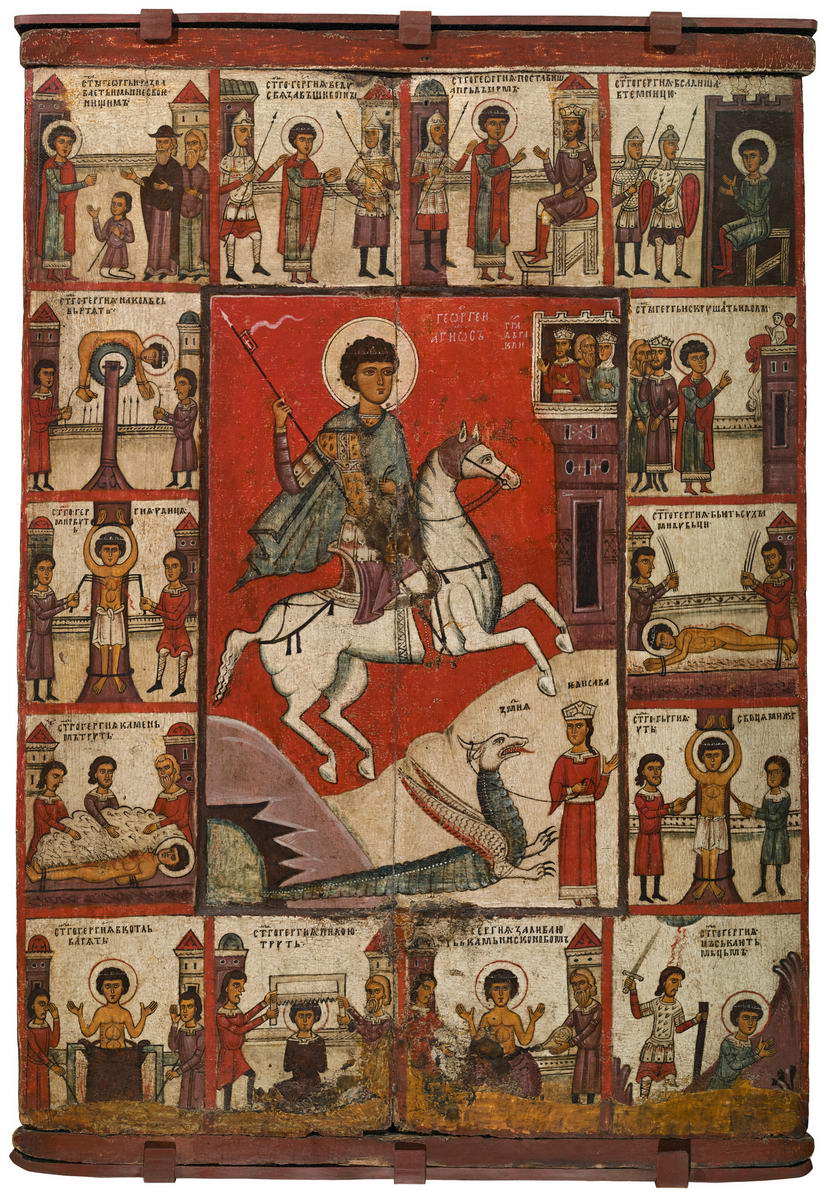
Чудо Георгия о змие, с житием в 14 клеймах / Георгий в житии
Новгород
Первая половина XIV века
Дерево, темпера, левкас. 86 × 63 × 2,5
Новгород
Пост. в 1898 году из Музея древнерусского искусства Академии художеств; ранее в собрании М. П. Погодина.
Одна из самых интересных житийных икон, принадлежащих искусству Новгорода, крупнейшего центра средневековой Руси. До 1851 года находилась в собрании М. П. Погодина (Москва), затем — в Синодальной ризнице и Мироваренной палате Московского Кремля, откуда в составе всей коллекции в 1870 году была передана в МАХ. Раскрыта до поступления в музей, повторно в 1912 году в ГРМ Г. И. Чириковым.
Христианский мученик Георгий, казненный во время гонений на христиан при императоре Диоклетиане (правил с 284 по 305), был одним из самых популярных на Руси святых. Особенно распространена легенда о спасении Георгием Елисавы-царевны, предназначенной в жертву змию, и освобождении «всей страны ливийской». В образе Георгия-змееборца воплотилось представление о доблестном воине, побеждающем силы зла, отсюда имя его на Руси — Победоносец. В нем видели и воина-защитника, и помощника в трудах земледельческих, а также покровителя невест.
Четырнадцать клейм вокруг центрального изображения — «средника» — иллюстрируют житие святого. В них преобладают сцены мучений («страстей»), призванные подчеркнуть духовную стойкость и мужество героя и сопровождаемые надписями:
– Георгий раздает свое богатство нищим
– Воины везут связанного Георгия
– Георгий перед царем
– Георгий в темнице
– Мучения на колесе
– Георгий сокрушает идолов
– Мучения удицами
– Избиение дубовыми прутьями
– Георгия камнями трут
– Мучение свечами
– Георгия в котле варят
– Мучение пилой
– Мучение кипящей смолой
– Усекновение главы Георгия

Miracle of St.George and the Dragon, with Scenes from his Life
Novgorod
Первая половина XIV века
Wood, tempera, gesso. 86 х 63 х 2,5
St George, one of Byzantium’s most revered saints, was canonised in Ancient Rus and his feastday established under the reign of Yaroslav the Wise, who received the martyr’s name in baptism.At that time St George became the patron saint of Russian princes, and his image would come to play an important role in Russia’s religious and political life, appearing both on the coat of arms and coins of Muscovy. The saint was revered in equal measure as a valiant warrior and defender of the Russian land (“Egory Khrabry”) and as a patron of farmers and herdsmen. Innumerable traditions and rituals were connected with the saint’s feastday in the Old Russian calendar. According to folk legend, George on his steed was the first to enter the then-uninhabited land of Rus, which he settled, christened with the “baptismal faith” and took under his protection. These notions were likely responsible for the incredible popularity of St George’s icon in Ancient Rus (especially the northern and Novgorod lands), where an abbreviated iconography of George the Horseman and Dragon-Slayer a rose based on the saint’s post humous miracle of the dragon and maiden. More than simply illustrating the vita of St George, this heraldic image has a much broader symbolic meaning, representing the victory of goodness and faith over the forces of evil.
Parts:
- St. George gives away his possessions to the poor
- Warriors arrest St. George
- St. George before the Emperor
- St. George in prison
- St. George tortured on the wheel
- St. George destroys idols
- St. George tortured with rods
- St. George is flogged
- St. George “crushed by a rock”
- Torture with candles
- St. George “boiled in a cauldron”
- St. George tortured with a saw
- St. George boiled in pitch
- St. George’s is beheaded.







